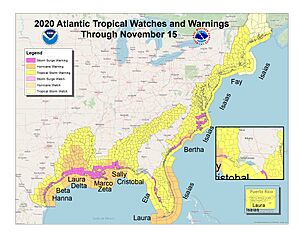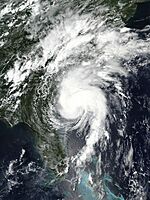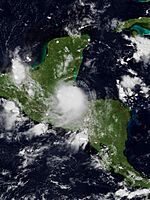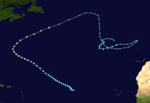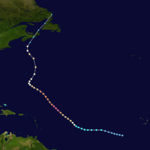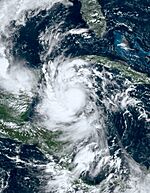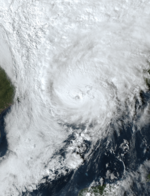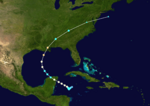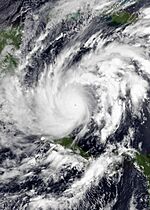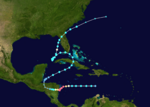2020 Atlantic hurricane season facts for kids
Quick facts for kids 2020 Atlantic hurricane season |
|
|---|---|
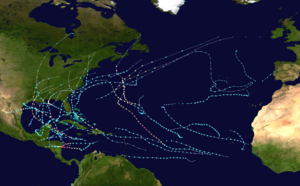
Season summary map
|
|
| Seasonal boundaries | |
| First system formed | May 16, 2020 |
| Last system dissipated | November 18, 2020 |
| Strongest storm | |
| Name | Iota |
| • Maximum winds | 155 mph (250 km/h) (1-minute sustained) |
| • Lowest pressure | 917 mbar (hPa; 27.08 inHg) |
| Seasonal statistics | |
| Total depressions | 31 (record high, tied with 2005) |
| Total storms | 30 (record high) |
| Hurricanes | 14 |
| Major hurricanes (Cat. 3+) |
7 (record high, tied with 2005) |
| Total fatalities | 432 total |
| Total damage | > $54.336 billion (2020 USD) |
| Related articles | |
|
|
The 2020 Atlantic hurricane season was the busiest Atlantic hurricane season ever recorded, based on the number of storms. It had 31 tropical and subtropical storms. Almost all of them became named storms. Out of 30 named storms, 14 grew into hurricanes. A record-tying seven of these became major hurricanes. Major hurricanes are storms that reach Category 3 or higher on the Saffir–Simpson scale.
This was the second and last time the Greek alphabet was used for naming storms. The first time was in 2005, which also set a record. In 2020, 11 named storms hit the contiguous United States. This broke the old record of nine set in 1916. Also, 27 tropical storms formed earlier in the year than any previous storms of their number. This season also saw a record ten tropical cyclones that quickly grew stronger. This tied the record from 1995. It also tied the record for the most Category 4 hurricanes in one Atlantic season.
This super active season happened because of a La Niña weather pattern. This pattern started in the summer of 2020. It continued a trend of busy hurricane seasons that began in 2016. Even with all this activity, no Category 5 hurricanes formed in 2020. This was the first time that happened since 2015.
The season officially ran from June 1 to November 30. However, storms can form at any time. For example, Tropical Storms Arthur and Bertha formed early, on May 16 and May 27. This was the sixth year in a row with a storm before the official season started. It was also the second year to have two such storms.
The first hurricane, Hanna, hit Texas on July 25. Hurricane Isaias formed on July 31. It hit The Bahamas and North Carolina in early August as a Category 1 hurricane. Isaias caused about $4.8 billion in damage. In late August, Laura hit Louisiana as a Category 4 hurricane. It was one of the strongest storms to hit the state based on wind speed. Laura caused at least $19 billion in damage and 77 deaths.
September was the busiest month ever in the Atlantic, with ten named storms. Slow-moving Hurricane Sally caused major flooding along the United States Gulf Coast. The Greek alphabet was used for the second and final time. This started on September 17 with Subtropical Storm Alpha. Alpha hit Portugal the next day.
Hurricane Zeta hit Louisiana on October 28. It was the fourth named storm to hit the state that year. This tied the record from 2002. Zeta also hit the United States later in the year than any other major hurricane on record. On October 31, Hurricane Eta formed. It hit Nicaragua as a Category 4 hurricane on November 3. Eta caused at least 175 deaths and $8.3 billion in damage.
Then, on November 10, Tropical Storm Theta became the 29th named storm of the season. This was a new record. Three days later, Hurricane Iota formed in the Caribbean. Iota quickly grew into a very strong Category 4 hurricane. This made 2020 the only season with two major hurricanes in November. Iota hit the same part of Nicaragua that Eta had hit just weeks before. It caused huge damage.
Overall, the storms of the 2020 Atlantic hurricane season caused at least 432 deaths. They also caused over $55.4 billion in damage.
Contents
- Hurricane Season Predictions
- Season Highlights
- Storms of the Season
- Tropical Storm Arthur
- Tropical Storm Bertha
- Tropical Storm Cristobal
- Tropical Storm Fay
- Hurricane Hanna
- Hurricane Isaias
- Hurricane Laura
- Hurricane Marco
- Hurricane Nana
- Hurricane Paulette
- Hurricane Sally
- Hurricane Teddy
- Tropical Storm Beta
- Subtropical Storm Alpha
- Hurricane Delta
- Hurricane Zeta
- Hurricane Eta
- Hurricane Iota
- Storm Names Used in 2020
- Season's Impact
- More to Explore
Hurricane Season Predictions
Experts predict how active each hurricane season will be. These predictions come from groups like Colorado State University (CSU) and the NOAA. An average hurricane season (from 1981 to 2010) usually has about 12 tropical storms, 6 hurricanes, and 3 major hurricanes.
The first prediction for 2020 came out in December 2019. It suggested a slightly busier-than-average season. This was because of warm ocean temperatures and normal wind patterns. In April and May 2020, other groups also made predictions. Some, like the University of Arizona and North Carolina State University, expected a very active season. They thought there was a high chance of hurricanes hitting the Caribbean and the United States.
NOAA also predicted an above-normal season in May 2020. They noted that La Niña conditions were expected during the busiest part of the season.
After the season began, forecasters updated their predictions. They generally expected a very active year. The Atlantic Ocean had very little wind shear and low air pressure in July. This led to predictions for a near-record-breaking season. CSU and Tropical Storm Risk (TSR) predicted 24 named storms. NOAA predicted between 19 and 25 named storms. This was one of the most active forecasts NOAA had ever released for an Atlantic hurricane season.
Season Highlights

The 2020 Atlantic hurricane season was extremely busy. Storms formed at a record-breaking speed. The third named storm, and every storm from the fifth one onward, formed earlier in the year than in any other season since 1851.
In late July, Hanna hit South Texas as the first hurricane of the season. Then came Isaias, the second hurricane, which moved through the Caribbean and the eastern United States. July 2020 tied 2005 for the busiest July ever, with five named storms.
Hurricanes Laura and Marco formed in late August. Laura became the first major hurricane of the season. It hit southwest Louisiana on August 27 as a Category 4 hurricane with 150 mph (240 km/h) winds.
September was the peak of the hurricane season. Nine named storms formed that month. Hurricane Nana hit Belize in early September. Paulette was the first hurricane to hit Bermuda since Gonzalo in 2014. Hurricane Sally hit the Gulf Coast of the United States as a slow-moving Category 2 hurricane.
Teddy, the season's eighth hurricane and second major hurricane, formed on September 12. Vicky formed two days later. With Vicky, five tropical cyclones were active at the same time in the Atlantic. This had not happened since 1971. Alpha formed unusually far east in the Atlantic. It was the first tropical cyclone ever to hit Portugal. Beta became a tropical storm, making September 2020 the busiest month on record with 10 named storms.
October and November were also very active. Seven named storms developed, and five of them became major hurricanes. This was more than twice the number recorded during this time in any previous season. Hurricane Gamma hit the Yucatán Peninsula in early October. A few days later, Hurricane Delta hit the same area. Delta then struck Louisiana as a hurricane on October 9. Hurricane Epsilon became a major hurricane near Bermuda.
Towards the end of October, Hurricane Zeta hit the Yucatán Peninsula and then Louisiana. It was the latest a major hurricane had ever hit the continental United States. In November, two Category 4 hurricanes hit Nicaragua within two weeks. Hurricane Eta moved from Central America to the Greater Antilles and the southeastern United States. The last hurricane of the season, Hurricane Iota, was also the strongest. It had winds of 155 mph (250 km/h) before hitting Nicaragua. The 2020 season was the first with two major hurricanes in November.
A total of 11 named storms hit the United States. This broke the previous record of nine from 1916. Six hurricanes hit the country, tying records from 1886 and 1985. Eight of the 11 named storms hit the Gulf Coast. Damage from the season totaled about $37 billion. Six hurricanes caused at least $1 billion in damage. This was two more than the previous record of four in 2004 and 2005.
Almost the entire coastline from Texas to Maine had some kind of tropical storm watch or warning. Only a few counties in Florida were exceptions. Louisiana was hit especially hard in 2020. The state had four landfalls: three hurricanes and one tropical storm. This tied the record set in 2002. Outside the United States, a record 13 landfalls occurred. The two November hurricanes in Central America set back economic development in Honduras by 22 years.
Storms of the Season
Tropical Storm Arthur
| Tropical storm | |
| Duration | May 16 – May 19 |
|---|---|
| Peak intensity | 60 mph (95 km/h) (1-min) 990 mbar (hPa) |
The first tropical depression of 2020 formed on May 16. It was about 125 miles (200 km) east of Melbourne, Florida. It quickly became Tropical Storm Arthur. Arthur reached its strongest point on May 19 with winds of 60 mph (95 km/h). The storm then became a non-tropical storm and faded away near Bermuda. Arthur brought heavy rain to the Bahamas, Cuba, and Florida. It caused $112,000 in damage. Arthur also brought rain and storm surge to North Carolina.
Tropical Storm Bertha
| Tropical storm | |
| Duration | May 27 – May 28 |
|---|---|
| Peak intensity | 50 mph (85 km/h) (1-min) 1005 mbar (hPa) |
Tropical Storm Bertha formed off the northeast coast of Florida on May 27. It had peak winds of 50 mph (85 km/h). That day, Bertha hit land near Isle of Palms, South Carolina. It quickly weakened. Bertha then became a non-tropical storm over Virginia and disappeared. Before Bertha, heavy rain fell in Miami, Florida, causing local flooding. One person drowned in South Carolina due to strong currents from the storm. Bertha caused at least $133,000 in damage.
Tropical Storm Cristobal
| Tropical storm | |
| Duration | June 1 – June 9 |
|---|---|
| Peak intensity | 60 mph (95 km/h) (1-min) 988 mbar (hPa) |
On June 1, the remains of a Pacific storm entered the Bay of Campeche. It quickly reformed into Tropical Storm Cristobal. The storm hit land near Ciudad del Carmen, Mexico, on June 3. It then weakened but grew stronger again over the Gulf of Mexico. Cristobal brought heavy rain to Mexico, causing three deaths. In El Salvador, a mudslide caused seven people to go missing. Cristobal later hit southeastern Louisiana. It weakened as it moved north and disappeared over the Hudson Bay. Cristobal killed three people in the United States. The total damage was about $665 million.
Tropical Storm Fay
| Tropical storm | |
| Duration | July 9 – July 11 |
|---|---|
| Peak intensity | 60 mph (95 km/h) (1-min) 998 mbar (hPa) |
Tropical Storm Fay formed on July 9 near Cape Hatteras, North Carolina. It moved north and reached its strongest point with winds of 60 mph (95 km/h). Fay hit land near Atlantic City, New Jersey, on July 10. It quickly lost strength inland and disappeared over Canada. Fay caused two direct deaths from strong currents. Four more people drowned later due to high waves. Damage from Fay in the Northeastern United States was at least $350 million. New Jersey was hit hard with heavy rain and flooding. Many roads closed, and 10,000 people lost power.
Hurricane Hanna
| Category 1 hurricane | |
| Duration | July 23 – July 26 |
|---|---|
| Peak intensity | 90 mph (150 km/h) (1-min) 973 mbar (hPa) |
Hurricane Hanna formed on July 23 in the Gulf of Mexico. It became a hurricane on July 25. Hanna reached its peak with winds of 90 mph (150 km/h) before hitting Padre Island, Texas. It quickly weakened after moving inland and disappeared. In Florida, a man drowned trying to save his son. Hanna caused storm surge, strong winds, and heavy rain in South Texas. It destroyed mobile homes and left 200,000 homes without power. In the United States, Hanna caused about $1.2 billion in damage. In Mexico, Hanna caused four deaths and about $100 million in damage.
Hurricane Isaias
| Category 1 hurricane | |
| Duration | July 30 – August 4 |
|---|---|
| Peak intensity | 90 mph (150 km/h) (1-min) 986 mbar (hPa) |
Tropical Storm Isaias formed on July 30 in the eastern Caribbean Sea. It hit the Dominican Republic and the Bahamas. Isaias became a hurricane. It weakened to a tropical storm but then became a hurricane again on August 3. Isaias hit Ocean Isle Beach, North Carolina, with 90 mph (150 km/h) winds. It weakened over the Mid-Atlantic states and disappeared over Quebec. Isaias caused 17 deaths in the Caribbean and eastern United States. Damage was over $4.8 billion. Isaias caused flooding and wind damage in Puerto Rico and the Dominican Republic. In the United States, it caused 39 tornadoes. One tornado in North Carolina killed two people. Almost 3 million people lost power.
Hurricane Laura
| Category 4 hurricane | |
| Duration | August 20 – August 29 |
|---|---|
| Peak intensity | 150 mph (240 km/h) (1-min) 937 mbar (hPa) |
Tropical Storm Laura formed on August 20. It became a hurricane on August 25 in the Gulf of Mexico. Laura quickly grew stronger, becoming a Category 4 hurricane. It reached its peak with 150 mph (240 km/h) winds. Laura hit land near Cameron, Louisiana, on August 27. It was the strongest hurricane to hit Louisiana since 1856. Laura weakened over land and disappeared. Laura brought heavy rain to Guadeloupe and Dominica. It caused huge damage in Louisiana. Storm surge went almost 35 miles (55 km) inland. Winds reached 153 mph (246 km/h) in Holly Beach, Louisiana. Laura destroyed about 10,000 homes and damaged over 130,000 others in Louisiana. Damage in Louisiana alone was about $17.5 billion. Texas was also hit hard with power outages and tree damage. Laura caused 16 tornadoes in the United States. There were 81 storm-related deaths. 47 were direct deaths, including 31 in Haiti, 9 in the Dominican Republic, and 7 in the United States.
Hurricane Marco
| Category 1 hurricane | |
| Duration | August 21 – August 25 |
|---|---|
| Peak intensity | 75 mph (120 km/h) (1-min) 991 mbar (hPa) |
Tropical Depression Fourteen formed on August 21 near Nicaragua and Honduras. It became Tropical Storm Marco. It strengthened into a hurricane on August 23 in the Gulf of Mexico. Marco had maximum winds of 75 mph (120 km/h). It weakened to a tropical storm as it neared Louisiana. Marco turned west and did not make landfall. It disappeared on August 25. Heavy rains fell along the Gulf Coast, causing flooding in Panama City Beach. Marco caused about $35 million in damage.
Hurricane Nana
| Category 1 hurricane | |
| Duration | September 1 – September 3 |
|---|---|
| Peak intensity | 75 mph (120 km/h) (1-min) 994 mbar (hPa) |
Tropical Storm Nana formed on September 1 southeast of Kingston, Jamaica. It became a hurricane on September 3 near Belize. Nana had winds of 75 mph (120 km/h). It hit land about 50 miles (80 km) south of Belize City. Nana quickly weakened over land and disappeared. The hurricane caused over $20 million in damage in Belize. Winds destroyed crops and caused coastal flooding. Heavy rain also fell in Guatemala and Mexico.
Hurricane Paulette
| Category 2 hurricane | |
| Duration | September 7 – September 22 |
|---|---|
| Peak intensity | 105 mph (165 km/h) (1-min) 965 mbar (hPa) |
Tropical Depression Seventeen formed on September 7. It quickly became Tropical Storm Paulette. Paulette strengthened into a hurricane on September 13. It hit Bermuda on September 14 with 100 mph (160 km/h) winds. The storm reached its strongest point later that day with 105 mph (165 km/h) winds. Paulette then weakened and became a non-tropical storm. It later reformed into a tropical storm before disappearing. Paulette caused two deaths and one injury due to strong currents along the U.S. East Coast. On Bermuda, winds reached 97 mph (156 km/h). The hurricane caused 25,000 power outages, affecting 70% of the island. Damage on Bermuda was about $50 million.
Hurricane Sally
| Category 2 hurricane | |
| Duration | September 11 – September 17 |
|---|---|
| Peak intensity | 110 mph (175 km/h) (1-min) 965 mbar (hPa) |
Tropical Depression Nineteen formed on September 11 over the Bahamas. It hit Cutler Bay, Florida, and then entered the Gulf of Mexico. It strengthened into Tropical Storm Sally. Sally became a hurricane on September 14. It slowed down and became a strong Category 2 hurricane. Sally hit Gulf Shores, Alabama, on September 16 with 110 mph (175 km/h) winds. It quickly weakened over land and disappeared. Sally caused nine deaths and about $7.3 billion in damage across the United States. It caused widespread power outages, affecting at least 560,000 people. Sally brought heavy rain and flooding to South Florida. It destroyed about 50 buildings in the Florida Panhandle. There were 23 tornadoes reported in the Southeastern United States.
Hurricane Teddy
| Category 4 hurricane | |
| Duration | September 12 – September 23 |
|---|---|
| Peak intensity | 140 mph (220 km/h) (1-min) 945 mbar (hPa) |
Tropical Depression Twenty formed on September 12. It became Tropical Storm Teddy on September 14. Teddy strengthened into a hurricane on September 16. Two days later, it reached its peak with 140 mph (220 km/h) winds. Teddy weakened but passed east of Bermuda. It then became a non-tropical storm and hit Atlantic Canada near Ecum Secum, Nova Scotia. Teddy caused large ocean waves along the U.S. Atlantic coast and in the Caribbean. These waves killed three people. High tides caused coastal flooding in South Carolina and North Carolina. About 220 homes lost power in Bermuda. Teddy's remnants caused wind gusts up to 90 mph (145 km/h) in Nova Scotia. About 18,000 customers in Atlantic Canada lost electricity. Damage from Teddy was about $35 million.
Tropical Storm Beta
| Tropical storm | |
| Duration | September 17 – September 22 |
|---|---|
| Peak intensity | 65 mph (100 km/h) (1-min) 993 mbar (hPa) |
Tropical Depression Twenty-Two formed in the Gulf of Mexico on September 17. It became Tropical Storm Beta on September 18. Beta reached its peak with 65 mph (100 km/h) winds. The storm slowed down, causing it to weaken. Beta hit land near Port O'Connor, Texas, on September 22. It then weakened and became a non-tropical storm. Beta brought heavy rain, with over 15 inches (380 mm) in Brookside Village, Texas. The rain caused flooding in the Greater Houston area, leading to one drowning death. Beta caused about $225 million in damage in the United States. Flooding required over 100 water rescues and closed several highways.
Subtropical Storm Alpha
| Subtropical storm (SSHS) | |
| Duration | September 17 – September 19 |
|---|---|
| Peak intensity | 50 mph (85 km/h) (1-min) 996 mbar (hPa) |
Subtropical Storm Alpha formed on September 17 east of the Azores. Alpha strengthened to 50 mph (85 km/h) winds. On September 18, the storm hit land near Figueira da Foz, Portugal. It disappeared the next day. Alpha caused over $1 million in damage. One person died in Spain due to a collapsed roof. The storm also caused at least two tornadoes. In Spain, a weather front linked to Alpha caused a train to derail. Thunderstorms on Ons Island caused a forest fire.
Hurricane Delta
| Category 4 hurricane | |
| Duration | October 4 – October 10 |
|---|---|
| Peak intensity | 140 mph (220 km/h) (1-min) 953 mbar (hPa) |
Tropical Depression Twenty-Six formed on October 4 southeast of Jamaica. It quickly became Tropical Storm Delta. Delta then rapidly grew stronger, becoming a Category 4 hurricane. It reached its peak with 140 mph (220 km/h) winds. This rapid strengthening happened because of very warm ocean water and low wind shear. Delta weakened and hit the Mexican state of Quintana Roo as a Category 2 hurricane. It weakened over land but grew stronger again over the Gulf of Mexico. Delta hit land near Creole, Louisiana, with 100 mph (160 km/h) winds. This was about 10 miles (15 km) from where Hurricane Laura hit. Delta weakened over land and disappeared. Hurricane Delta caused six deaths: two in the Yucatán, two in Louisiana, and two in Florida. In Mexico, damage was about $185 million, with power outages and flooding. Damage in the United States reached $2.9 billion. Delta caused heavy rain, strong winds, storm surge, and tornadoes. In Louisiana, Delta caused more damage to buildings already hit by Laura. Flooding was a major problem, with over 17 inches (440 mm) of rain in LeBleu Settlement.
Hurricane Zeta
| Category 3 hurricane | |
| Duration | October 24 – October 29 |
|---|---|
| Peak intensity | 115 mph (185 km/h) (1-min) 970 mbar (hPa) |
Tropical Depression Twenty-Eight formed on October 24 near Grand Cayman. It quickly became Tropical Storm Zeta and then a hurricane on October 26. Zeta hit land near Ciudad Chemuyil, Mexico, with 85 mph (135 km/h) winds. It weakened but then became a hurricane again. Zeta reached its peak as a Category 3 major hurricane with 115 mph (185 km/h) winds. It made its second landfall near Cocodrie, Louisiana. Zeta quickly lost strength over land and disappeared. Heavy rain in Jamaica caused a landslide that killed two people. Zeta caused about $15 million in damage on the island. In Mexico, strong winds and rain caused flooding and damaged buildings. There were seven deaths in the United States: three in Georgia, two in Mississippi, and one each in Louisiana and Alabama. Damage in the United States totaled $4.4 billion. Zeta knocked out power to over 2.6 million homes and businesses. It also affected early voting for the 2020 election.
Hurricane Eta
| Category 4 hurricane | |
| Duration | October 31 – November 13 |
|---|---|
| Peak intensity | 150 mph (240 km/h) (1-min) 922 mbar (hPa) |
Tropical Depression Twenty-Nine formed on October 31. It strengthened into Tropical Storm Eta and quickly grew stronger as it neared Central America. On November 2, Eta reached its peak with 150 mph (240 km/h) winds. It hit land south-southwest of Puerto Cabezas, Nicaragua, on November 3 with 140 mph (225 km/h) winds. Over land, Eta quickly weakened. It later reformed into a tropical storm and hit eastern Cuba. Eta then moved across the Florida Keys into the Gulf of Mexico. It briefly became a hurricane again southwest of Florida before weakening. Eta made its final landfall near Cedar Key, Florida, on November 12. It weakened over land and disappeared. Over 210 people died across Central America due to Eta. Damage in Central America was about $6.8 billion. Eta caused flooding and landslides, destroying crops, roads, and homes. It damaged or destroyed at least 6,900 homes in Nicaragua. Relief efforts were made harder because Hurricane Iota hit the same area just two weeks later. Eta also brought heavy rain to the Cayman Islands and Cuba. The storm caused about $1.5 billion in damage in the United States, mostly from flooding.
Hurricane Iota
| Category 4 hurricane | |
| Duration | November 13 – November 18 |
|---|---|
| Peak intensity | 155 mph (250 km/h) (1-min) 917 mbar (hPa) |
Tropical Depression Thirty-One formed on November 13. It became Tropical Storm Iota. Iota quickly grew stronger, becoming a hurricane on November 15. It reached its peak with 155 mph (250 km/h) winds near Providencia Island. The hurricane hit eastern Nicaragua on November 17 with 145 mph (230 km/h) winds. Iota quickly weakened over land and disappeared over El Salvador. Its landfall was about 15 miles (25 km) south of where Eta hit. Hurricane Iota caused at least 84 deaths and about $1.4 billion in damage. It first affected Venezuela, damaging homes. Iota destroyed about 98% of the buildings on Providencia Island. Most of the damage was in Nicaragua and Honduras. In Nicaragua, wind damage was less because of Hurricane Eta's recent passage. However, Iota knocked down many power poles and damaged homes. Heavy rain caused widespread flooding and mudslides. Mexico also reported major impacts, with thousands of homes damaged.
Storm Names Used in 2020
The names listed below were used for storms in the North Atlantic in 2020. This was the same list used in 2014. No names were removed from that year's list. The names Isaias and Paulette were used for the first time in 2020. They replaced Ike and Paloma from 2008. Also, Rene, Sally, Teddy, Vicky, and Wilfred were used for the first time. When the main list of names ran out, the Greek letters Eta, Theta, and Iota were used. This was the second time the Atlantic hurricane season used up all 21 names and had to use the Greek alphabet. The first time was in 2005.
|
||
| Auxiliary list | ||
|
|
|
Names No Longer Used
On March 17, 2021, the World Meteorological Organization (WMO) decided to stop using the name Laura. This means it will not be used again for storms in the North Atlantic. Laura was replaced with Leah, which will first appear on the 2026 season list. The Greek letters Eta and Iota were also retired. The WMO also decided to stop using the Greek alphabet for extra storm names. A new list of 21 names was created to be used starting with the 2021 season.
The WMO did not retire the names of several other 2020 hurricanes that caused a lot of damage. These included Isaias, Sally, Delta, and Zeta. Sally was the most damaging of these four, causing about $7.3 billion in 2020 US dollars. This made Sally the most expensive non-retired North Atlantic hurricane ever recorded.
Season's Impact
This table shows all the tropical cyclones from the 2020 Atlantic hurricane season. It includes their name, how long they lasted, their strongest category and wind speeds, the areas they affected, and the damage and deaths they caused. Deaths in parentheses are indirect deaths, meaning they were related to the storm but not directly caused by it (like a car accident during the storm). All damage amounts are in 2020 US dollars.
| Saffir–Simpson scale | ||||||
| TD | TS | C1 | C2 | C3 | C4 | C5 |
| Storm name |
Dates active | Storm category
at peak intensity |
Max 1-min wind mph (km/h) |
Min. press. (mbar) |
Areas affected | Damage (USD) |
Deaths | Refs
|
||
|---|---|---|---|---|---|---|---|---|---|---|
| Arthur | May 16–19 | Tropical storm | 60 (95) | 990 | Southeastern United States, The Bahamas, Bermuda | $112,000 | None | |||
| Bertha | May 27–28 | Tropical storm | 50 (85) | 1005 | Southeastern United States, The Bahamas | > $130,000 | 1 | |||
| Cristobal | June 1–9 | Tropical storm | 60 (95) | 988 | Central America, Mexico, Central United States, Great Lakes region, Northern Ontario | ≥ $665 million | 6 | | ||
| Dolly | June 22–24 | Tropical storm | 45 (75) | 1000 | None | None | None | |||
| Edouard | July 4–6 | Tropical storm | 45 (75) | 1005 | Bermuda, southern Ireland, southern United Kingdom | Minimal | None | |||
| Fay | July 9–11 | Tropical storm | 60 (95) | 998 | East Coast of the United States, Southeastern Canada | ≥ $220 million | 2 (4) | | ||
| Gonzalo | July 21–25 | Tropical storm | 65 (100) | 997 | Windward Islands, Trinidad and Tobago, Venezuela | Minimal | None | |||
| Hanna | July 23–26 | Category 1 hurricane | 90 (150) | 973 | Greater Antilles, Gulf Coast of the United States, Mexico | $1.2 billion | 4 (5) | |||
| Isaias | July 30 – August 4 | Category 1 hurricane | 90 (150) | 986 | Lesser Antilles, Greater Antilles, Turks and Caicos Islands, The Bahamas, East Coast of the United States, Eastern Canada | $5.03 billion | 12 (5) | |||
| Ten | July 31 – August 1 | Tropical depression | 35 (55) | 1008 | Cabo Verde Islands | None | None | |||
| Josephine | August 11–16 | Tropical storm | 45 (75) | 1004 | None | None | None | |||
| Kyle | August 14–15 | Tropical storm | 50 (85) | 1000 | The Carolinas | None | None | |||
| Laura | August 20–29 | Category 4 hurricane | 150 (240) | 937 | Lesser Antilles, Greater Antilles, The Bahamas, Southern United States, Eastern United States | $23.3 billion | 47 (34) | | ||
| Marco | August 21–25 | Category 1 hurricane | 75 (120) | 991 | Lesser Antilles, Venezuela, Central America, Greater Antilles, Yucatán Peninsula, Gulf Coast of the United States | ≥ $35 million | None | | ||
| Omar | August 31 – September 5 | Tropical storm | 40 (65) | 1003 | Southeastern United States, Bermuda | None | None | |||
| Nana | September 1–3 | Category 1 hurricane | 75 (120) | 994 | Lesser Antilles, Jamaica, Cayman Islands, Central America, Southeastern Mexico | ≥ $20 million | None | |||
| Paulette | September 7–22 | Category 2 hurricane | 105 (165) | 965 | Cabo Verde Islands, Bermuda, East Coast of the United States, Azores, Madeira | > $50 million | 2 | | ||
| Rene | September 7–14 | Tropical storm | 45 (75) | 1001 | Senegal, The Gambia, Cabo Verde Islands | Minimal | None | |||
| Sally | September 11–17 | Category 2 hurricane | 110 (175) | 965 | The Bahamas, Cuba, Southeastern United States | $7.3 billion | 4 (5) | |||
| Teddy | September 12–23 | Category 4 hurricane | 140 (220) | 945 | Lesser Antilles, Greater Antilles, Bermuda, East Coast of the United States, Atlantic Canada | > $35 million | 3 | | ||
| Vicky | September 14–17 | Tropical storm | 50 (85) | 1001 | Cabo Verde Islands | Minimal | (1) | | ||
| Beta | September 17–22 | Tropical storm | 65 (100) | 993 | Mexico, Gulf Coast of the United States | $225 million | 1 | |||
| Wilfred | September 17–21 | Tropical storm | 40 (65) | 1006 | None | None | None | |||
| Alpha | September 17–19 | Subtropical storm | 50 (85) | 996 | Iberian Peninsula | > $24.2 million | (1) | | ||
| Gamma | October 2–6 | Category 1 hurricane | 75 (120) | 978 | Cayman Islands, Central America, Yucatán Peninsula | > $100 million | 6 | | ||
| Delta | October 4–10 | Category 4 hurricane | 140 (220) | 953 | Jamaica, Cayman Islands, Central America, Yucatán Peninsula, Gulf Coast of the United States | $3.09 billion | 2 (4) | |||
| Epsilon | October 19–26 | Category 3 hurricane | 115 (185) | 952 | Bermuda | Minimal | 1 | |||
| Zeta | October 24–29 | Category 3 hurricane | 115 (185) | 970 | Cayman Islands, Jamaica, Central America, Yucatán Peninsula, Gulf Coast of the United States, East Coast of the United States | ~$4.4 billion | 7 (2) | |||
| Eta | October 31 – November 13 | Category 4 hurricane | 150 (240) | 922 | San Andrés, Jamaica, Central America, Mexico, Cayman Islands, Cuba, The Bahamas, Southeastern United States | $7.24 billion | 189 | | ||
| Theta | November 10–15 | Tropical storm | 70 (110) | 987 | Canary Islands, Madeira | None | None | |||
| Iota | November 13–18 | Category 4 hurricane | 155 (250) | 917 | ABC Islands, Venezuela, Colombia, San Andrés and Providencia, Central America, Mexico | $1.4 billion | 67 (17) | |||
| Season Aggregates | ||||||||||
| 31 systems | May 16 – November 18 | 155 (250) | 917 | > $54.336 billion | 354 (78) | |||||
More to Explore
- Tropical cyclones in 2020
- List of Atlantic hurricane records
- 2020 Pacific hurricane season
- 2020 Pacific typhoon season
- 2020 North Indian Ocean cyclone season


